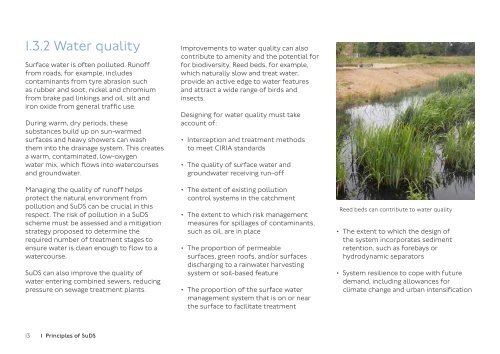SuDS in London - a guide
sustainable-urban-drainage-november-2016
sustainable-urban-drainage-november-2016
Create successful ePaper yourself
Turn your PDF publications into a flip-book with our unique Google optimized e-Paper software.
1.3.2 Water quality<br />
Surface water is often polluted. Runoff<br />
from roads, for example, <strong>in</strong>cludes<br />
contam<strong>in</strong>ants from tyre abrasion such<br />
as rubber and soot, nickel and chromium<br />
from brake pad l<strong>in</strong>k<strong>in</strong>gs and oil, silt and<br />
iron oxide from general traffic use.<br />
Dur<strong>in</strong>g warm, dry periods, these<br />
substances build up on sun-warmed<br />
surfaces and heavy showers can wash<br />
them <strong>in</strong>to the dra<strong>in</strong>age system. This creates<br />
a warm, contam<strong>in</strong>ated, low-oxygen<br />
water mix, which flows <strong>in</strong>to watercourses<br />
and groundwater.<br />
Manag<strong>in</strong>g the quality of runoff helps<br />
protect the natural environment from<br />
pollution and <strong>SuDS</strong> can be crucial <strong>in</strong> this<br />
respect. The risk of pollution <strong>in</strong> a <strong>SuDS</strong><br />
scheme must be assessed and a mitigation<br />
strategy proposed to determ<strong>in</strong>e the<br />
required number of treatment stages to<br />
ensure water is clean enough to flow to a<br />
watercourse.<br />
<strong>SuDS</strong> can also improve the quality of<br />
water enter<strong>in</strong>g comb<strong>in</strong>ed sewers, reduc<strong>in</strong>g<br />
pressure on sewage treatment plants.<br />
Improvements to water quality can also<br />
contribute to amenity and the potential for<br />
for biodiversity. Reed beds, for example,<br />
which naturally slow and treat water,<br />
provide an active edge to water features<br />
and attract a wide range of birds and<br />
<strong>in</strong>sects.<br />
Design<strong>in</strong>g for water quality must take<br />
account of:<br />
• Interception and treatment methods<br />
to meet CIRIA standards<br />
• The quality of surface water and<br />
groundwater receiv<strong>in</strong>g run-off<br />
• The extent of exist<strong>in</strong>g pollution<br />
control systems <strong>in</strong> the catchment<br />
• The extent to which risk management<br />
measures for spillages of contam<strong>in</strong>ants,<br />
such as oil, are <strong>in</strong> place<br />
• The proportion of permeable<br />
surfaces, green roofs, and/or surfaces<br />
discharg<strong>in</strong>g to a ra<strong>in</strong>water harvest<strong>in</strong>g<br />
system or soil-based feature<br />
• The proportion of the surface water<br />
management system that is on or near<br />
the surface to facilitate treatment<br />
Reed beds can contribute to water quality<br />
• The extent to which the design of<br />
the system <strong>in</strong>corporates sediment<br />
retention, such as forebays or<br />
hydrodynamic separators<br />
• System resilience to cope with future<br />
demand, <strong>in</strong>clud<strong>in</strong>g allowances for<br />
climate change and urban <strong>in</strong>tensification<br />
13 1 Pr<strong>in</strong>ciples of <strong>SuDS</strong>


